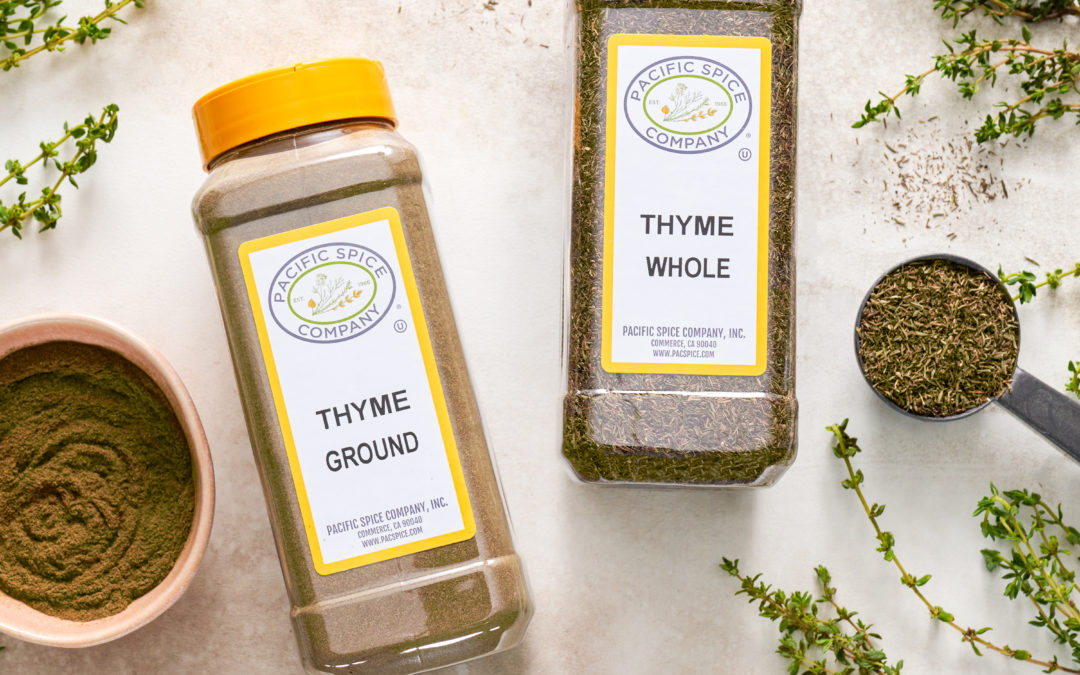Thyme (pronounced like the word “time”) is an herb that’s popular in many different spice blends and savory recipes, from New England Clam Chowder to Creole Seafood. In ancient times, it was shrouded in superstition and used for its many believed medicinal properties. Today, it is a prominent herb in spice cabinets across America.
In this blog, we’ll discuss the history, origins, and common uses of this fragrant herb.
Flavor
The thyme plant has hundreds of varieties and each one has a slightly different flavor, fragrance, and ideal use. The most common variety has a fresh, fragrant flavor that is often described as earthy, minty, and a bit citrusy. Its flavor is mild, balanced, and even a bit floral, like lavender or rosemary.
Appearance
Thyme comes from the Thymus vulgaris plant, a small shrub in the mint family that grows to be up to 18 inches tall. This plant is covered in small, gray-green leaves that are seldom longer than ¼ of an inch in length and produce .8-2% volatile oil.
Today, the Thymus vulgaris plant is cultivated around the world. That said, the wild variety is also still commonly harvested for the spice trade.
History
In ancient Greece, thyme was revered for its fragrance and was believed to have magical powers. This herb was a symbol of elegance, courage, and strength. In fact, “You smell of thyme” was one of the best compliments one could give to another in ancient Greece.
During that time, thyme was used to aid in both mental and physical ailments. People would stuff their pillows with it if they were experiencing sadness, sew a sprig of it into their uniform (for courage) before going off to war, and ingest it to soothe coughs, nightmares, indigestion, and a number of other ailments.
Today, thyme oil is used mainly for its fragrance and culinary use. In addition, scientists have created a synthetic version of thymol (its active ingredient) for use in the pharmaceutical industry for its believed carminative, antispasmodic and counter-irritant properties.
Origins/Quality Sourcing
Thyme is native to several countries including Spain, Egypt, and Morocco. It grows wild in sunny locations with a mild climate, on the hillsides of Southern Europe and in a number of other locations around the world, and is even cultivated domestically. It is commonly sold in both whole and ground form.
At Pacific Spice, we are dedicated to sourcing the highest quality spices. Our product is sourced from reputable, approved sources in Spain, Morocco, and Egypt to ensure a flavorful and dependable addition to your favorite dishes.
Storing
Thyme should be packaged and tightly sealed under cool, dark, dry conditions; above ground and away from the wall. Proper storage conditions will help to protect it against loss of fragrance or flavor. As a highly fragrant herb, it is imperative that this product is stored under optimal storage conditions to retain its flavor strength and integrity for up to one year or more.
Uses
Thyme is a highly versatile herb that can be used in a number of dishes including stuffing, salad dressing, gravy, and pasta. In cooking, it shines when it’s used to season heavy, creamy dishes such as:
- New England clam chowder
- Creamed chicken
It can also play a starring role in vegetable dishes such as:
- Braised celery
- Grilled asparagus
- Baked eggplant
- Creamed white onions
It’s important to note that thyme is a prominent herb in Mediterranean-inspired herb blends, often accompanying herbs like bay leaves, parsley, oregano, rosemary, and marjoram.
PSC Thyme
At Pacific Spice, we sell a number of products including:
- PSC Thyme Leaves Egyptian Ground
- PSC Thyme Leaves Egyptian Whole
- PSC Thyme Leaves Moroccan Ground
- PSC Thyme Leaves Moroccan Whole
- PSC Thyme Leaves Spanish Ground
- PSC Thyme Leaves Spanish Whole
If you’re interested in ordering from PSC, contact us about our products! When you source from us, we will help you determine the proper product for your project to maximize function, flavor, and consistency.

